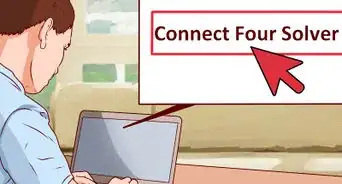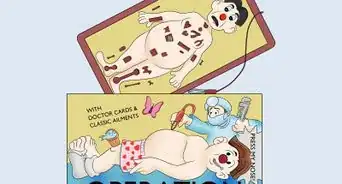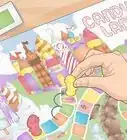This article was co-authored by Jessie Davidson. Jessie Davidson is a Child Care Specialist and the CEO and Founder of BabysitPro, which provides online courses for current and aspiring babysitters. Jessie has over 20 years of childcare experience and specializes in best practices for sitters of infants, toddlers, preschoolers, and grade-schoolers. BabysitPro’s courses are unique and age-specific so babysitters can learn detailed information relevant to the children they babysit. Jessie holds a BA in French Studies from Wheaton College and an MA in Visual Anthropology from The University of Southern California.
This article has been viewed 280,492 times.
The Game of Life allows you to live out an entire life on a game board: getting a job, starting a family, and (if you're lucky) retiring as a millionaire. The most recent edition is easy to set up, can be played by 2-4 players, and is the only version that adds pets to your life story. There are many older editions of the game too. These take a little more set up before your first time playing, but they let you squeeze up to 6 players in one game.
Steps
Latest Edition (2017): Set Up
-
1Punch the pegs out of the plastic frame. If you have a brand new set, the plastic pegs come in a rectangular frame. Punch these out carefully. There are 24 pink and blue "people" pegs and 12 smaller, green "pet" pegs.[1]
- If there are any sharp bits of plastic clinging to the pegs, shave them down with sandpaper or an emery board.
-
2Put the spinner in the empty corner of the board. Unfold the game board. Put the plastic spinner wheel on top of the blue sky corner of the board, between the paths marked "College Path" and "Career Path".[2]Advertisement
-
3Shuffle and separate the five decks. The backs of the cards are labeled House, Action, Career, College Career, and Pet. Separate these, shuffle them, and put them face down next to the game board.[3]
-
4Give each player their starting pieces. Each player starts with:
- 1 plastic car
- 1 flat, circular token the same color as their car
- 1 large "person" peg (all pegs fit into the holes in your car)
- 1 small "pet" peg (give your pet a name!)
- 200K of paper money
-
5Choose a banker. One player gets to be the banker. They're in charge of giving players their salary and bank loans. It's helpful for the banker to sit near the spinner, so they can store the bank's money in the attached plastic compartment.
- The banker is still a player, and keeps their own money separate from the bank's stash.
-
6Have each player choose Career or College. Your car can start next to either of the two arrows on the plastic spinner (between the wheel and the money compartment).[4] Each path has its advantages:
- If you pick Career, look at the top two cards of the Career deck. Pick one to put face up in front of you, and put the other on the bottom of the deck. You start on the shorter path and will start earning money sooner.
- If you pick College, pay the bank $100K. You start on the longer path and don't have a career yet, but you'll have a better chance at a high-paying job later.
Latest Edition (2017): Gameplay
-
1Spin the spinner and move that many squares. The youngest player goes first, then play continues left (clockwise) around the table. Each turn starts with one spin to see how many squares you move.
- Read your Career card for special "bonus number" instructions. Other players have to pay you a certain amount of money if their spin lands on your bonus number.[5]
-
2Draw an Action card when you land on Gold. When you land on a yellow square with a faint circle image on it, draw the top card of the Action deck. Read it aloud and do what it says.[6]
- Keep the card—it's worth money at the end of the game.
-
3Draw a Pet card when you land on the pink paw. Read the card aloud and follow its instructions.
- Keep the card next to you after you're done, since it's worth money at the end of the game.
-
4Play the Spin to Win minigame when you land on the spinner. Each player puts their circular token next to a number on the "Spin to Win" image in the corner of the board. The player whose turn it is takes the extra, silver token out of the box and chooses a second number. Spin the spinner until it points to a number someone has chosen. That player wins $200K from the bank.[7]
-
5Add pegs to your car when you land on Baby squares. Add one pink or blue peg to your car if the square says "Baby". Add two if it says "Twins". (Each baby is worth 50K at the end of the game.)[8]
-
6Collect salary when you pass a Payday square. Unlike most squares, you don't have to land exactly on a green Payday square. Whenever you pass one, collect the salary listed on your Career card.[9]
- When you land exactly on a Payday square, collect your salary plus a 100K bonus!
-
7Buy and sell houses on a House square. When you land on these squares, you have three options:[10]
- You can choose to do nothing.
- You can buy a house: Draw two cards from the House deck. Pick one to keep, pay the bank the price listed on the card, and put the second card on the bottom of the deck.
- You can choose one of your houses to sell, if you have one: Spin the spinner, and look at the inner circle to see if it landed on red or black. Collect the amount of money listed on your House card next to that color. Put that House card on the bottom of the deck.
-
8Stop moving when you hit a STOP square. Even if you have extra moves left, your piece stops here. Follow the special instructions for the STOP square you're on:[11]
- Graduation: Look at the top two College Career cards, pick one to put in front of you, and put the other on the bottom of the deck. Spin and move again.
- Get Married: Add a blue or pink peg (your spouse) to your car. Spin and look at the inner circle: if it's red, everyone gives you 50K each; if it's black, everyone gives you 100K. Spin and move again.
- Night School: You can choose to pay the bank 100K, draw the top card of the College Career deck, and (if you want) replace your old Career with the new card. Spin again and move on the Night School path. Or you can choose to not pay anything, spin again, and move on the Life path.
- Family: Spin again and move onto either the Family path (if you want kids) or the Life path (if you don't).
- Spin for babies: Follow the instructions on the square, add that many people pegs to your car, then spin and move again.
- Risky/Safe: Spin and move again onto either path. The Risky road has some squares with special instructions that can make or lose you money.[12]
-
9Get a bank loan if you run out of money. If you don't have enough money to buy something or pay a debt, ask for a loan. The banker gives you the amount you need from the bank's supply, plus one bank loan certificate for every 50K you borrow. Each bank loan certificate takes away 60K from your final score.[13]
-
10Retire at the end of the game. Unlike earlier versions of the game, the two end spaces ("Millionaire's Mansion" and "Countryside Acres") are there just for fun; it doesn't matter which you pick. You do get a bonus for retiring first, though:[14]
- The first to retire gets 400K.
- The second gets 300K.
- The third gets 200K.
- The fourth gets 100K.
-
11Count money at the end of the game to see who wins. Once everyone has gone through the whole board and retired, whoever has the most money wins. But before you count, there are a few extra steps that will change your score:[15]
- Sell your Houses by spinning the wheel for each one and looking at the inner wheel color (red or black). You get the amount of money listed on your House card next to that color.
- Get 100K for each Action card and each Pet card.
- Get 50K for each baby you have.
- Lose 60K for each bank loan certificate you have.
Older Editions: Board Assembly
-
1Punch out game board pieces and the cardboard slots on the game board. The Game of Life comes with many cardboard parts that you will need to punch out and attach to the board. It also comes with some plastic pieces that you will need to attach to the board in the correct places.[16]
-
2Put stickers on the mountain and bridge pieces. Your Game of Life set should have stickers for the mountain and bridge pieces. Put these stickers on the mountain and bridge pieces before you attach them to the game board.[17]
-
3Attach the game parts to the board. Before you start playing, you will need to assemble the board. Attach the buildings, mountains, and bridges to the correct places on the board. Each plastic piece has a letter on it that matches up with a letter on the board.[18]
- Match the letter piece with the correct letter on the board. For example, the “J” piece should go into the “J” slot.
-
4Assemble and attach the spinner. The Game of Life uses a spinner instead of dice. You will need to put this spinner together and attach it to the board before you play your first game. Punch out the cardboard spinner and match the notches up with the notches on the plastic spinner dial. Then, snap the two pieces together.[19]
- Next attach the spinner dial to the spinner base. The spinner base should have a letter on it that corresponds to the letter on the board. Snap the assembled spinner into place on the board.
Older Editions: Set Up
-
1Place the Life tiles somewhere near the board. Make sure that they are all facing down. Mix them up and leave them next to the board to act as the draw pile. Take four tiles without looking at them and place them on the Millionaire Estates space.[20]
-
2Separate, shuffle, and stack the cards. The four types of cards are Career Cards, Salary Cards, House Deeds, and Stocks. Make sure that you keep each type of card separate and then shuffle each stack. Place the stacks face-down somewhere next to the board where everyone can reach them.[21]
-
3Find the Automobile Insurance Policies, Homeowner’s Insurance Policies, Stocks, and Bank Loans. Place these items somewhere near the board. Players will purchase and borrow these items throughout the game, so you will want to have them somewhere that is easy to access. Select a spot right next to the game board to keep these items for when they are needed.[22]
-
4Select someone to be the Banker. The Banker is in charge of all money going into and out of the bank. Make sure the person who decides to be the Banker is aware that he/she will need to collect and distribute money throughout the game. The Banker will need to distribute $10,000 in Life money to each player.[23]
-
5Have everyone choose a car and people peg. The Game of Life comes with six car movers in different colors as well as people pegs that go in the cars. Make sure that every player chooses a car and puts a peg into it before placing that peg on the board.[24]
Older Editions: Gameplay
-
1Decide if you want to start a career or go to college. Before your first turn, you will need to decide if you want to start the game with a career card or start the game by going to college. There are advantages and disadvantages to both options.[25]
- The advantages of starting your career right away is that you will start earning PAY DAY money sooner and you will not have any debt. The disadvantages of starting your career right away is that you will not earn as much money and there are some career cards that you may not take.
- The advantage of going to college is that you will earn more when you do get a career card. The disadvantage of going to college is that you will have $40,000 in debt and it will take you longer to get your career card.
-
2Draw a Career Card right away if you decide to start a career. If you choose to start a career, then you will need to choose a career card right away. Discard any career cards that indicate that a college degree is required, such as the doctor career card.[26]
-
3Place your car on the Start College space if you decided to start college. If you are going to start college, then you will need to place your car on the start college space. You may not draw a career card yet. You may draw a career card when you reach the Job Search space.[27]
-
4Spin the wheel. Each play will need to spin the wheel at the beginning of every turn. The number that you spin will indicate how many spaces you may move your car on the board. You may only move your car forward, not backwards on the board.[28]
-
5Observe the instructions for different space colors. The Game of Life board is very colorful and each space has different instructions that you will need to read and follow. Take some time to review the basic instructions for the space colors so that you will know what your options are.[29]
- Orange spaces have instructions written on them that you must follow.
- Blue spaces have instructions on them that you may decide to follow or not follow.
- Green spaces are PAY DAY spaces. Collect the amount shown on your PAY DAY card whenever you pass or land on a green space.
- Red spaces require you to stop moving, even if you have enough moves left to go past a red space. You have to stop whenever you encounter a red space. Follow the instructions on the space, then spin and move again.
-
6Pay if you land on a career space that someone or no one owns. The career spaces on the board match the available career cards. If one of your opponents owns the card, then you need to pay that opponent the amount shown on the card.[30]
- If you own the career card, then you do not have to pay anything.
- If no one owns the career card, then you need to pay the amount indicated on the space to the bank.
-
7Give $5,000 to the person with the police officer career card if you spin a 10. This rule is known as the Special Police Officer Rule. If someone spins a 10, then that person is said to have been “speeding” and must pay whoever has the Police Officer career card $5,000. If no one has the card, then no one has to pay.[31]
-
8Pay $5,000 to the accountant if you land on the “Taxes” space. The accountant gets an extra space on the board which is called the Taxes space. If you land on this space, then you need to pay $5,000 to whoever has the accountant career card.[32]
- If no one has this card, then pay $5,000 to the bank.
- If you have the card, then you pay nothing.
-
9Decide if you want to take out an automobile insurance policy or homeowner’s insurance policy. You may choose to purchase an insurance policy at the beginning of one of your turns. These policies will offer some protection for your home or car (depending on which one you buy) in case of an accident.[33]
- Auto insurance costs $10,000, but the homeowner’s insurance policies depend on the home that you own. You can find the cost of a homeowner’s insurance policy on your deed card.
-
10Buy stocks. You may buy a stock card at the beginning of one of your turns. A stock card costs $50,000, but if someone spins and lands on the number on your card, then you collect $10,000 from the bank. This rule applies whether you are spinning or someone else is spinning.[34]
- You may only buy one stock card, but you may get another stock card if you land on the Stock Market Zooms space.
-
11Take out a bank loan if you need it. If you are running low on cash, then you may take out a bank loan of $20,000 at the beginning of one of your turns. Keep in mind that you will have to repay this amount to the bank when you retire plus an extra $5,000 in interest.[35]
Older Editions: Winning
-
1Stop moving when you reach the Retire space. When you have reached the Retire space, you may not spin the wheel any more or draw cards, or purchase things. This space indicates that you are near the end of the game. However, getting to the Retire space first does not mean you have won the game.[36]
-
2Repay your loans plus any interest you owe. The first thing you will need to do when you hit the Retire space is to repay any loans you have taken out plus the interest that you owe. Put this money back into the bank.[37]
-
3Discard your Career Card, Salary Card, Insurance Policies, and House Deed. Next, get rid of all of your special cards, but you may keep your stocks. If you are ahead of your opponents, then you can continue to collect money from your stocks when your opponents spin the wheel.[38]
-
4Move your car to Millionaire Estates OR Countryside Acres. Move to Millionaire Estates if you think that you have the most money. Keep in mind that if you do move to Millionaire Estates, you stand a chance to collect four additional Life tiles that may help you win the game. But other players may draw from this pile if the draw deck is empty.[39]
- If you move to Countryside Acres, collect one Life tile. No one may take this Life tile from you and you may include it in your cash total at the end of the game.
-
5Have all of the players at Millionaire Estates count up their money. The player with the most money gets the last four life tiles that are on the Millionaire Estates space. Then, all of the players (including those at Countryside Acres) should add the cash amounts on their Life tiles with the money they have on hand. The player with the most money is the winner![40]
- You can take this game with you while babysitting.
- Even if the house is full of toys, whatever you bring along will be exciting and special for the kids.
- Parents will notice that you are proactive and are better than other babysitters who arrive empty-handed.
Community Q&A
-
QuestionHow do I sue for damages?
 Community AnswerYou have to get an action card that says you can file a lawsuit, and then you have to choose a player to sue.
Community AnswerYou have to get an action card that says you can file a lawsuit, and then you have to choose a player to sue. -
QuestionWhat if you go to college later in the game, do you keep your first career or change and do you get the 100,000 dollars of debt?
 Community AnswerYou do still have to pay the 100K. In the newest version of the game, you get the College Career right away when you choose Night School. In the older versions of the game, you keep your first career until the end of the College path when you get a new job.
Community AnswerYou do still have to pay the 100K. In the newest version of the game, you get the College Career right away when you choose Night School. In the older versions of the game, you keep your first career until the end of the College path when you get a new job. -
QuestionHow do I choose when buying a house?
 Community AnswerTo buy a house, have someone fan out the cards, then you pick two. Pick one of those two to be your house.
Community AnswerTo buy a house, have someone fan out the cards, then you pick two. Pick one of those two to be your house.
References
- ↑ https://images-eu.ssl-images-amazon.com/images/I/B1nJeqPbjiS.pdf
- ↑ https://youtu.be/OGhyPqBE1Mw
- ↑ https://images-eu.ssl-images-amazon.com/images/I/B1nJeqPbjiS.pdf
- ↑ https://youtu.be/OGhyPqBE1Mw
- ↑ https://youtu.be/OGhyPqBE1Mw
- ↑ https://images-eu.ssl-images-amazon.com/images/I/B1nJeqPbjiS.pdf
- ↑ https://images-eu.ssl-images-amazon.com/images/I/B1nJeqPbjiS.pdf
- ↑ https://bargames101.com/game-of-life-rules/
- ↑ https://images-eu.ssl-images-amazon.com/images/I/B1nJeqPbjiS.pdf
- ↑ https://images-eu.ssl-images-amazon.com/images/I/B1nJeqPbjiS.pdf
- ↑ https://images-eu.ssl-images-amazon.com/images/I/B1nJeqPbjiS.pdf
- ↑ https://i5.walmartimages.com/asr/dd6e6ae5-ddfb-4ec9-9ef2-11126734847c_1.40f588e28c290d4cb8d1f4052e7acd0d.jpeg
- ↑ https://images-eu.ssl-images-amazon.com/images/I/B1nJeqPbjiS.pdf
- ↑ https://images-eu.ssl-images-amazon.com/images/I/B1nJeqPbjiS.pdf
- ↑ https://images-eu.ssl-images-amazon.com/images/I/B1nJeqPbjiS.pdf
- ↑ http://www.hasbro.com/common/instruct/Life_the_game_of_2000.PDF
- ↑ http://www.hasbro.com/common/instruct/Life_the_game_of_2000.PDF
- ↑ http://www.hasbro.com/common/instruct/Life_the_game_of_2000.PDF
- ↑ http://www.hasbro.com/common/instruct/Life_the_game_of_2000.PDF
- ↑ http://www.hasbro.com/common/instruct/life.pdf
- ↑ http://www.hasbro.com/common/instruct/life.pdf
- ↑ http://www.hasbro.com/common/instruct/life.pdf
- ↑ http://www.hasbro.com/common/instruct/life.pdf
- ↑ http://www.hasbro.com/common/instruct/life.pdf
- ↑ http://www.hasbro.com/common/instruct/life.pdf
- ↑ http://www.hasbro.com/common/instruct/life.pdf
- ↑ http://www.hasbro.com/common/instruct/life.pdf
- ↑ http://www.hasbro.com/common/instruct/life.pdf
- ↑ http://www.hasbro.com/common/instruct/life.pdf
- ↑ http://www.hasbro.com/common/instruct/life.pdf
- ↑ http://www.hasbro.com/common/instruct/life.pdf
- ↑ http://www.hasbro.com/common/instruct/life.pdf
- ↑ http://www.hasbro.com/common/instruct/life.pdf
- ↑ http://www.hasbro.com/common/instruct/life.pdf
- ↑ http://www.hasbro.com/common/instruct/life.pdf
- ↑ http://www.hasbro.com/common/instruct/life.pdf
- ↑ http://www.hasbro.com/common/instruct/life.pdf
- ↑ http://www.hasbro.com/common/instruct/life.pdf
- ↑ http://www.hasbro.com/common/instruct/life.pdf
- ↑ http://www.hasbro.com/common/instruct/life.pdf
About This Article
To play the Game of Life, first place all of the LIFE tiles face-down next to the game board. Take 4 of those tiles and place them face-down at Millionaire Estates. Separate the game cards into 4 piles—career cards, salary cards, house deed cards, and stock cards—and place the piles next to the board. You should also separate the insurance policies and bank loans into 3 separate piles next to the board. Choose a player to be the banker, who is in charge of handing out money during the game, and have them give each player $10,000 to start with. Each player also starts with a car and one people peg. Once the game is set up, each player spins the wheel. Whoever spins the highest number goes first, and play continues clockwise. On a player’s turn, they spin the wheel and move their car that number of spaces forward on the board. On the first turn of the game, players decide whether they want to immediately start a career or go to college first. Going to college gives players more career options, but it takes longer and costs money. If a player wants to go to college, they place their car on the START COLLEGE space and collect $40,000 in bank loans. If a player wants to start their career immediately, they place their car on the START CAREER space and draw one career card and one salary card. If they draw a card that has “Degree Required” on it, they must draw a different career. Players place their career and salary cards face up in front of them. When players land on orange spaces, they must follow the directions on the space. Blue spaces have optional directions. Green spaces are PAY DAY spaces. Whenever a player lands on or passes a green space, they collect their salary from the bank. Red spaces are event spaces. Players must stop at these spaces, follow the directions, and then spin and move again. If a player lands on a LIFE space, they draw 1 life tile and keep it face-down in front of them until the end of the game. There are also career spaces on the board. If a player lands on a career space, they pay the player who has the career listed on the space the amount of money specified on the space. If no player has that career, they pay the money to the bank instead. Players can purchase automobile insurance for $10,000 at the beginning of any turn, which protects their car from any accidents, damage, and theft. They can also buy homeowner’s insurance for the amount specified on their house deed card to protect their home from floods, tornadoes, and theft. Players are also able to buy 1 stock at the beginning of any turn for $50,000. Whenever a player spins the number listed on a stock card, the player who owns that stock card collects $10,000 from the bank. Players can only own 1 stock at a time. Players are able to take out 1 or more bank loans during their turn. Bank loans must be repaid with $5,000 in interest at the end of the game. When players reach the RETIRE space on the board, they must stop and pay off any outstanding loans, remove their career card, salary card, insurance policies, and house deed from play, and place their car on either Millionaire Estates or Countryside Acres. Players should choose Millionaire Estates if they think they have the most money. Otherwise, they should choose Countryside Acres. Once all of the players have retired, each player at Millionaire Estates counts their money. The player with the most money gets the 4 LIFE tiles that were placed at Millionaire Estates at the beginning of the game. Now any players at Countryside Acres count their money. Finally, all players flip over their collected LIFE tiles and add the value of each tile to their total. The player with the most money wins the game! To learn more, including how to decide whether to start a career or go to college, read on.

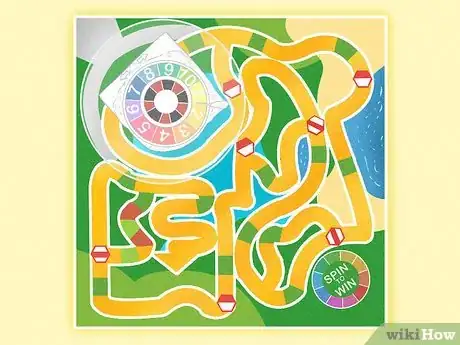


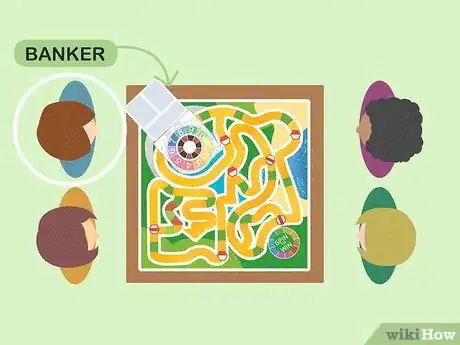
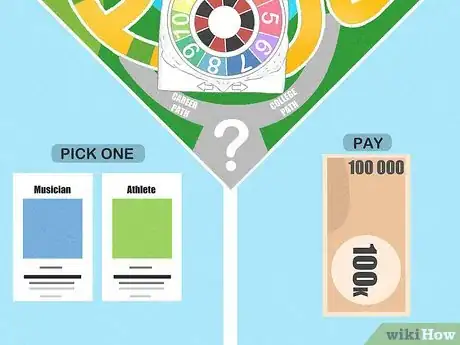
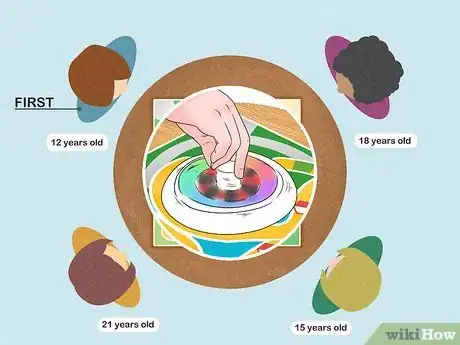
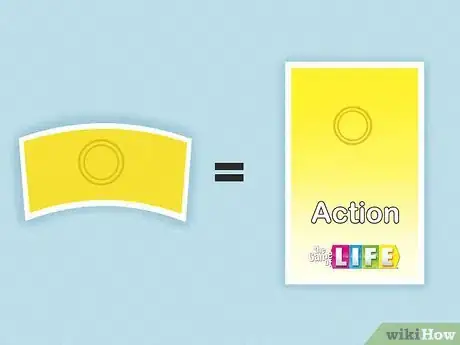
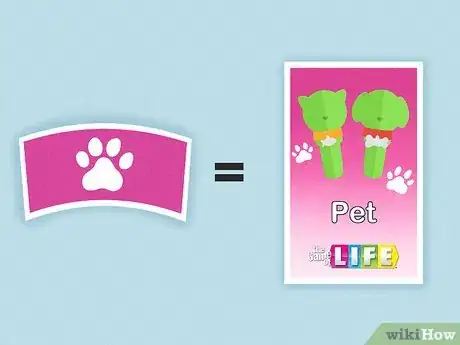
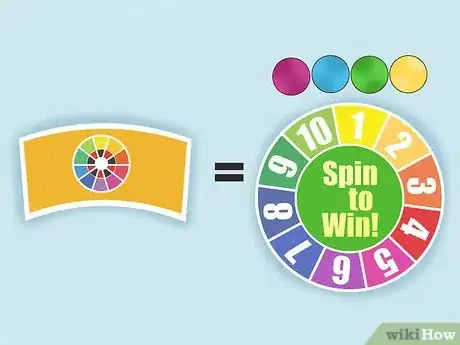
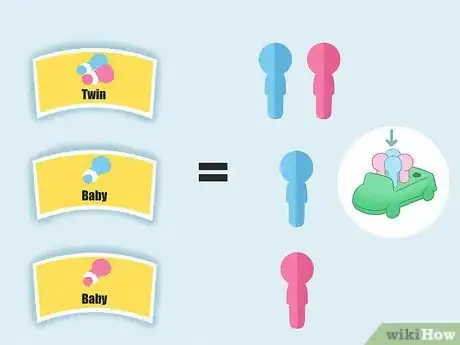

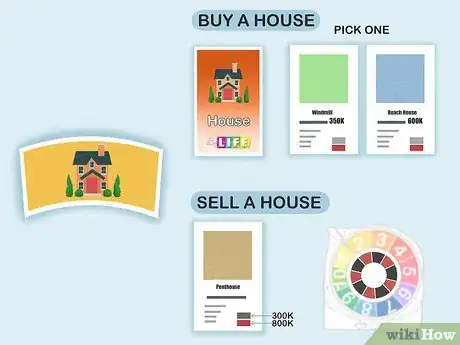

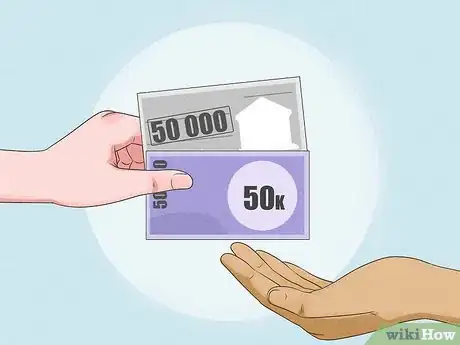
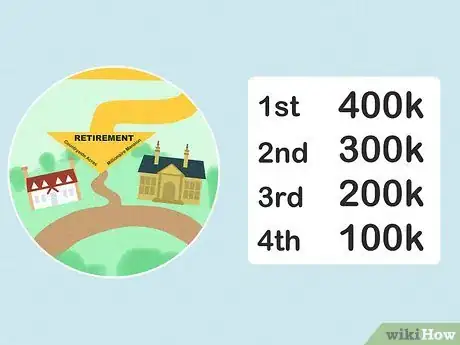
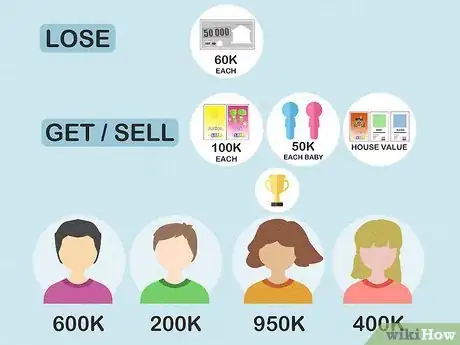
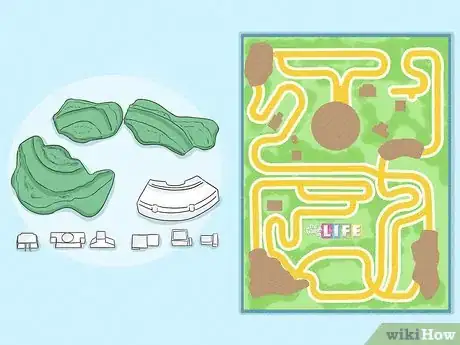
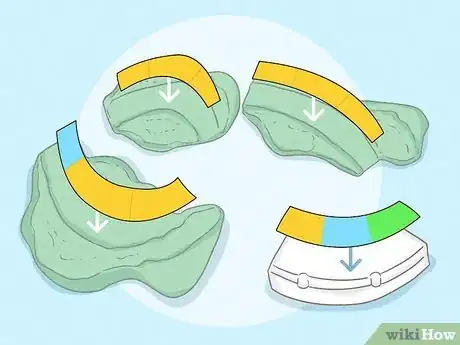
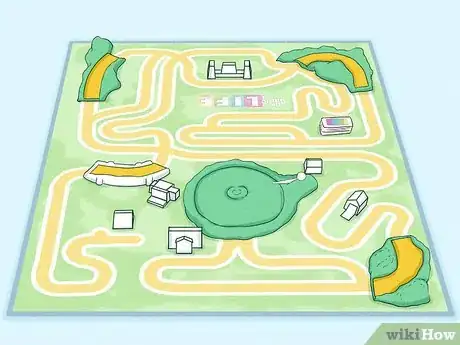
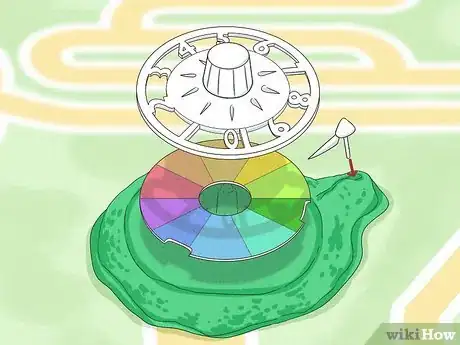
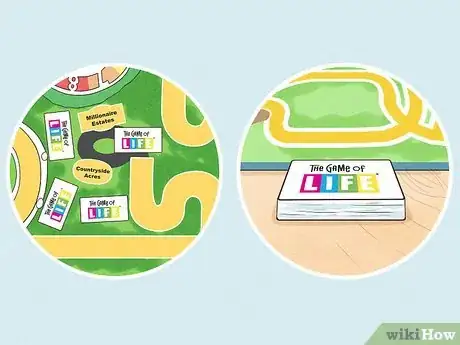
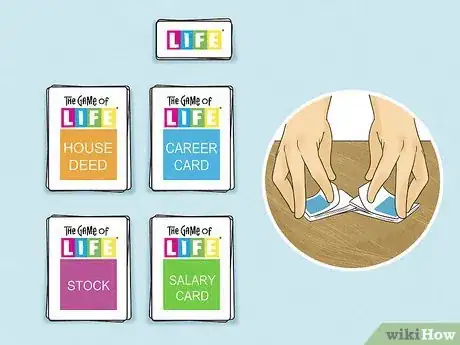
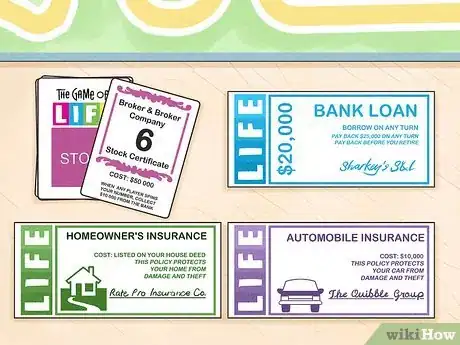
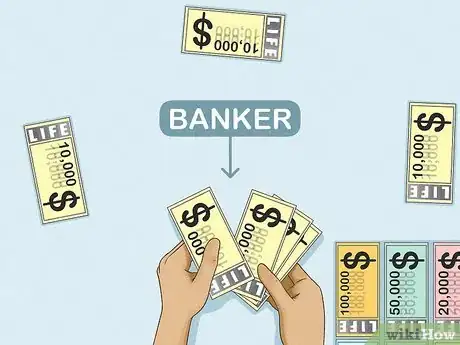



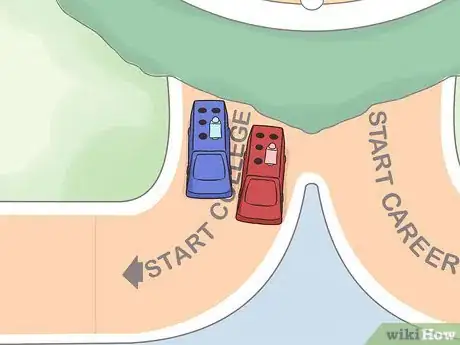
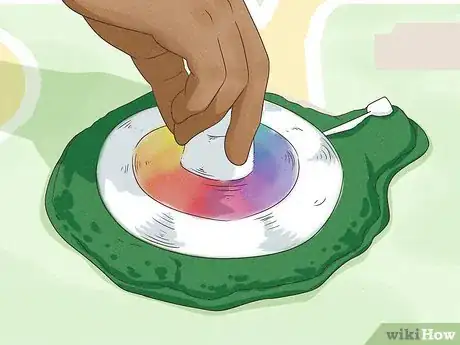
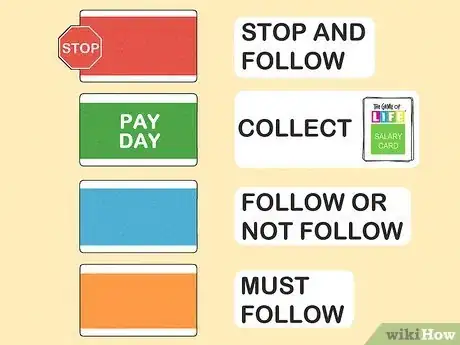
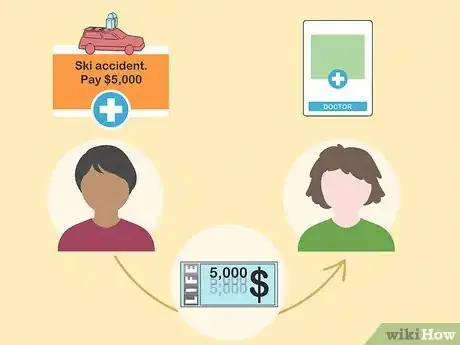
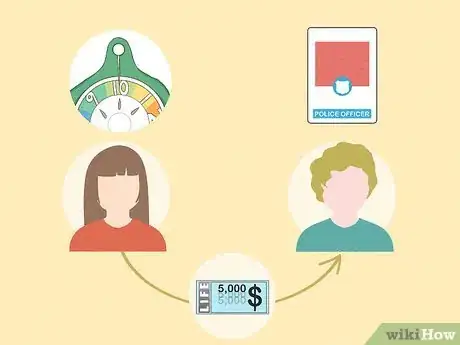
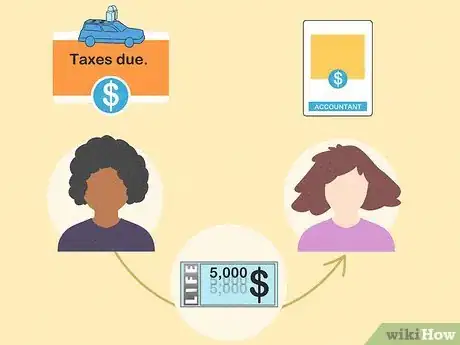
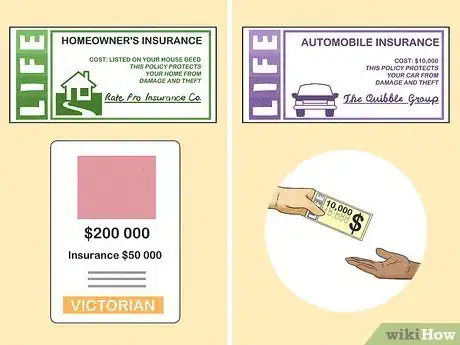

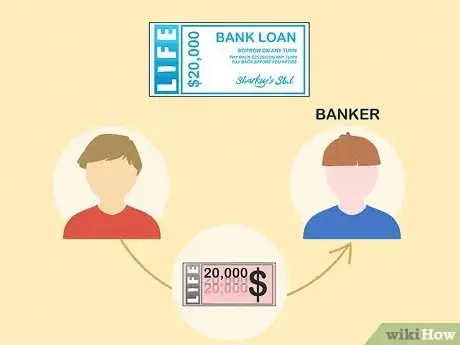
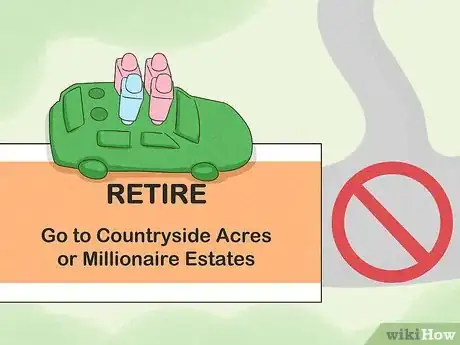
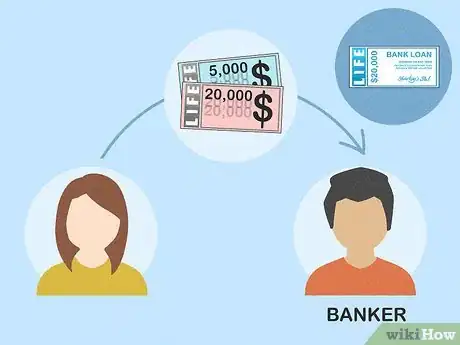
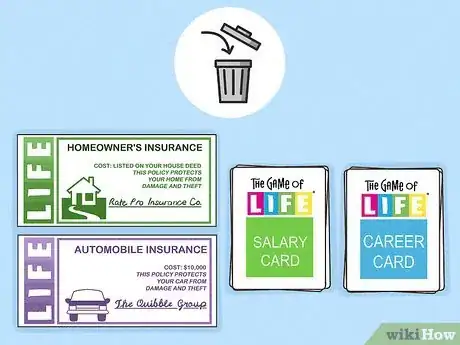
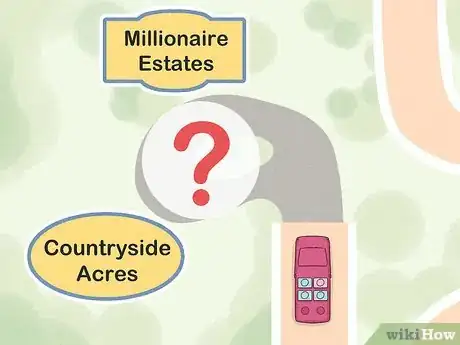
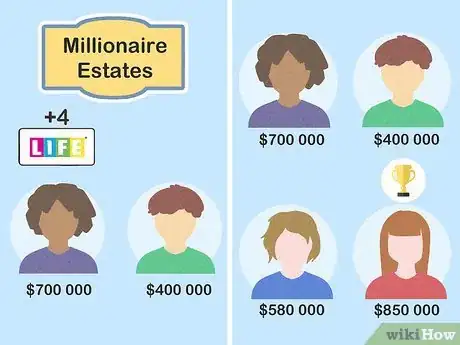

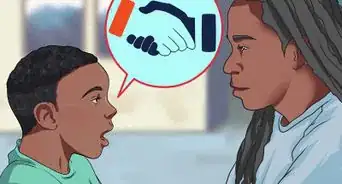

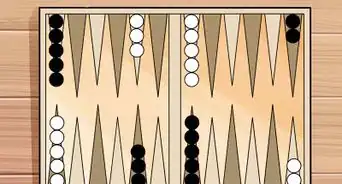
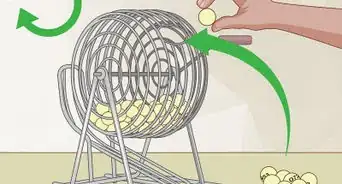
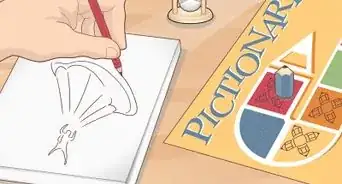

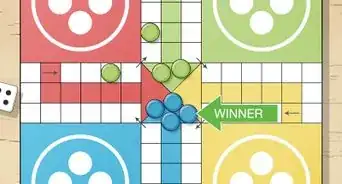

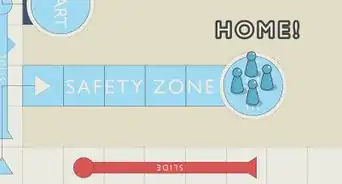
-Step-10-Version-2.webp)
